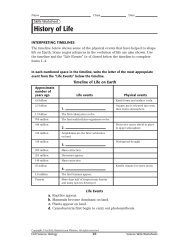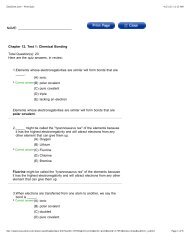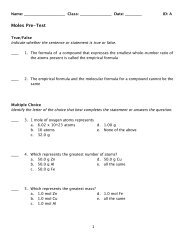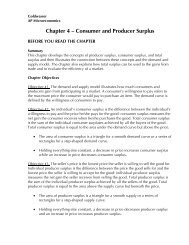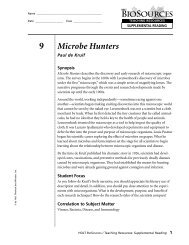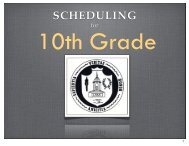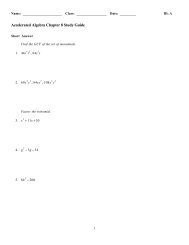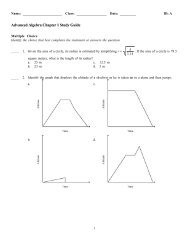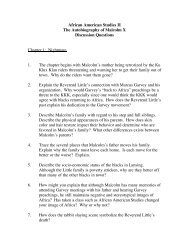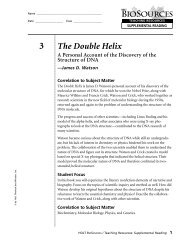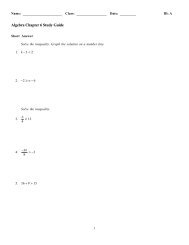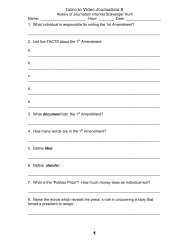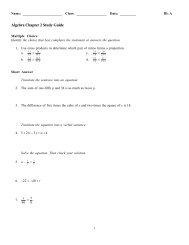Silent Spring Book Report Worksheet.pdf
Silent Spring Book Report Worksheet.pdf
Silent Spring Book Report Worksheet.pdf
- No tags were found...
Create successful ePaper yourself
Turn your PDF publications into a flip-book with our unique Google optimized e-Paper software.
Name _______________________________________________________Date _______________________Class ________________________TEACHING RESOURCESSUPPLEMENTAL READING10<strong>Silent</strong> <strong>Spring</strong>—Rachel CarsonSynopsis<strong>Silent</strong> <strong>Spring</strong> is a nonfiction text that explores the impact of humans, and theirproducts, on the environment. Written over 30 years ago, this text was an earlyattempt to develop environmental awareness among the general public. RachelCarson, the author, was a biologist who studied the effects of pesticides on theenvironment. She conducted her research during the 1950s, a time when the useof pesticides was a relatively new process. The scientific community knew littleabout the long-term effects such products would have on the Earth. The generalpublic knew even less. Pesticides were used without caution and in great quantitiesbecause the benefit of pest eradication seemed to be the only consideration.As a scientist, Carson became concerned by the attempt of humans to controlnature. Her research indicated that most manmade chemicals adversely affectedthe balance of nature. Pesticides were reducing populations, including humans,that were never intended to be targets. Armed with the results of her research,she became an unofficial spokesperson for the natural world. She wrote <strong>Silent</strong><strong>Spring</strong> to counteract the prevailing idea of the time that “nature exists for theconvenience of man.” Her text attempts to help people develop respect for thenatural world and encourage the realization that the naive or reckless use ofchemicals in this world will ultimately destroy the users.© by Holt, Rinehart and Winston, Inc.Student FocusIn order to obtain the fullest understanding of this work, you must take note ofthe sequence of events that Rachel Carson describes within the text. You shouldrecognize that the scientific community, as well as the general public, knew verylittle about the side effects of many pesticides that had been developed. Youshould also focus on the cause-and-effect relationships between pesticides andthe natural world that are described by Carson. You should appreciate that manyof the relationships were only inferred at the time the novel was written. However,in the decades since <strong>Silent</strong> <strong>Spring</strong> was published, many of Carson’s premiseshave, unfortunately, proved to be tragically prophetic.Correlation to Subject MatterPlants, Bacteria, Pollution, Cancer, Mutations, and Food ChainsHOLT BIOSOURCES / Teaching Resources: Supplemental Reading 1
SUPPLEMENTAL READING<strong>Silent</strong> <strong>Spring</strong>continuedAnalyzing the <strong>Book</strong>IdentifyingFacts1. Why does the author feel that insecticides should be called biocides?2. How did World War II contribute to the growth of insecticides?3. How do chemists produce the cleaning fluid carbon tetrachloridefrom methane?4. For what purpose was DDT originally used?5. What effect do organic phosphorus insecticides have on living organisms?6. What results when pairs of organic phosphate insecticides are combined?© by Holt, Rinehart and Winston, Inc.2 HOLT BIOSOURCES / Teaching Resources: Supplemental Reading
SUPPLEMENTAL READING continued Name _______________________________________________________<strong>Silent</strong> <strong>Spring</strong>Date _______________________ Class ________________________7. What are systemic insecticides?8. Identify three ways that earthworms benefit soil.9. How do insecticides disturb the balance of populations residing in the soil?10. Can an insecticide that is sprayed on an organism affect the future generationsof that organism? Explain how.© by Holt, Rinehart and Winston, Inc.11. How can spraying a forest with an insecticide affect fish residing in aforest stream?12. What type of food products generally contain the heaviest residues of chlorinatedhydrocarbons? Explain why.HOLT BIOSOURCES / Teaching Resources: Supplemental Reading 3
SUPPLEMENTAL READING<strong>Silent</strong> <strong>Spring</strong>continued13. Identify two methods of preventing the contamination of public food suppliesthat are recommended by the author.14. What are carcinogens? Give an example of one.InterpretingMeanings15. What does the title <strong>Silent</strong> <strong>Spring</strong> represent?16. According to Carson, what relationship exists between the physical propertiesof carbon and the great diversity of life?17. Does Carson feel that humans should ever interfere with the relationshipsthat exist among Earth’s vegetation? Explain your answer.© by Holt, Rinehart and Winston, Inc.4 HOLT BIOSOURCES / Teaching Resources: Supplemental Reading
SUPPLEMENTAL READING continued Name _______________________________________________________<strong>Silent</strong> <strong>Spring</strong>Date _______________________ Class ________________________18. How can the use of DDT actually boost an insect population?19. Describe Warburg’s theory of the relationship between cancer cells and fermentation.© by Holt, Rinehart and Winston, Inc.20. According to the author, what two important facts have been overlooked inthe design of insect control programs?HOLT BIOSOURCES / Teaching Resources: Supplemental Reading 5
SUPPLEMENTAL READING<strong>Silent</strong> <strong>Spring</strong>continuedApplyingMeanings21. Does Carson feel that humans can “control nature”? Explain why.22. Explain how the spraying for Dutch elm disease eventually yielded evidencethat the chain of poisoning grows as it progresses through a food chain.© by Holt, Rinehart and Winston, Inc.6 HOLT BIOSOURCES / Teaching Resources: Supplemental Reading
SUPPLEMENTAL READING continued Name _______________________________________________________<strong>Silent</strong> <strong>Spring</strong>Date _______________________ Class ________________________Writing About the <strong>Book</strong>On a separate sheet of paper, write the answer to each of the following questions.Extending the Story1. Rachel Carson based her novel on evidence collected during the 1950s.Unfortunately, many other episodes of humans interfering with the balanceof nature have unfolded since that time. Write an epilogue to the novel whichdetails one such episode.Thinking about Assumptions2. The idea that humans can “control nature” is based upon certain assumptions.In the last chapter of the novel, the author details her very strong feelingsabout these assumptions. Do you agree with her position? Explain whyor why not.Responding to a Review3. It has been said that <strong>Silent</strong> <strong>Spring</strong> is a “courageous revelation of the forces thatmodern man has brought into being in his ruthless war on life, a protest onbehalf of the unity of all nature, a protest on behalf of life”. Write an essay inwhich you react to this statement. Do you think that humanity’s war on lifecontinues today? Be sure to use specific references to support your answer.Evaluating a Character4. Rachel Carson wrote that this book was “an attempt to explain what hasalready silenced the voices of spring in countless towns in America”. Do youthink Carson was successful in her attempt? Explain why.© by Holt, Rinehart and Winston, Inc.Writing a Journal Entry5. Imagine that you are gathering additional evidence of how humans interferewith the balance of nature. Write an entry in your field journal describing evidenceof the disruption you observe in your own town.Analyzing the Cause6. If you had been Rachel Carson, what would you have done after writing thisbook to continue educating the general public about the dangers of pesticides?Write an essay in which you clearly describe three different actions youwould take. Explain your reasons for each.HOLT BIOSOURCES / Teaching Resources: Supplemental Reading 7
SUPPLEMENTAL READING<strong>Silent</strong> <strong>Spring</strong>continuedTesting on the <strong>Book</strong>On a separate sheet of paper, write the answer to each of the following questions.Critical Thinking and Writing1. Albert Schweitzer is quoted in the text as stating, “Man has lost the capacity toforesee and forestall. He will end by destroying the earth.” Does the theme of<strong>Silent</strong> <strong>Spring</strong> support this statement? Explain how.2. The use of insecticides in Clear Lake was based upon erroneous assumptions.Identify these assumptions and describe their results.3. Throughout the novel, Carson describes ironic situations in which the predictedoutcome of an action was just the opposite of what actually occurred.Describe one such situation. Be sure to clearly describe what professionalsbelieved would occur and what actually happened.4. Pretend that you are the author. Are you a proponent of nuclear energy or areyou against this alternative energy source? Write an essay in which you stateyour opinion. Be sure to give reasons for your stand on the issue.5. Farmers use pesticides to increase the yield of their crops. Greater yieldmeans lower prices for the consumer. Would you be willing to pay higherprices for fruits and vegetables that are grown in “pesticide-free” environments?Explain why.© by Holt, Rinehart and Winston, Inc.8 HOLT BIOSOURCES / Teaching Resources: Supplemental Reading



